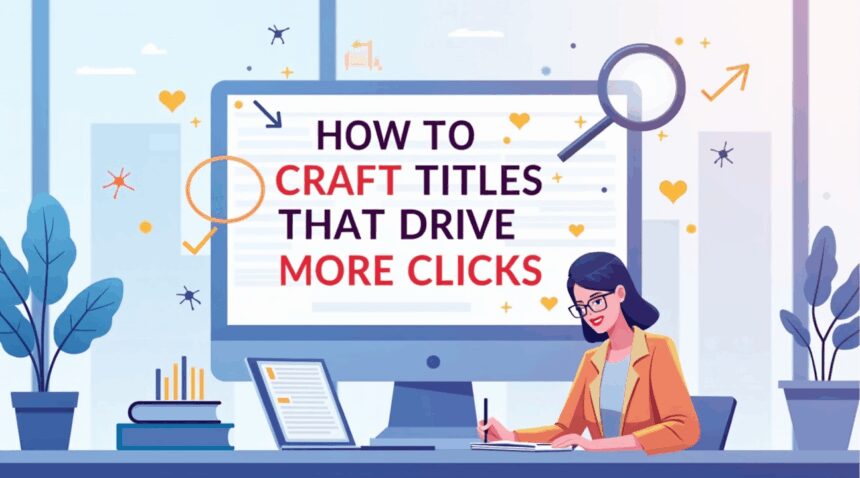Effective blog titles function as the critical gateway between content and potential readers, with research showing that well-crafted headlines can boost click-through rates by up to 36%. This comprehensive guide reveals proven techniques for creating compelling titles, engaging introductions, and structured content that captures attention while driving meaningful reader engagement and search engine visibility.
Key Takeaways
- Keep titles under 60 characters and place primary keywords within the first three words to maximize search visibility and reader comprehension
- Use the Hook-Pain-Promise formula for introductions that capture attention within 15 seconds by combining compelling hooks with clear problem identification and solution promises
- Structure content with strategic H2 and H3 headings to improve time-on-page by 24% while maintaining parallel formatting and natural keyword placement
- Incorporate visual elements and proper formatting to increase content views by up to 94%, including optimized images under 150KB and strategic use of white space and bullet points
- End with strategic calls-to-action that guide readers to specific next steps, whether subscribing, sharing, or engaging with the community
How to Craft Titles That Drive 36% More Clicks and Grab Attention Instantly
I’ve discovered that effective blog titles function as the gateway between your content and potential readers. The difference between a compelling headline and a mediocre one often determines whether someone clicks through or scrolls past your article entirely.
Smart bloggers understand that titles must work within specific constraints while maximizing impact. Google typically displays the first 50-60 characters of a title in search results, making brevity essential. When your SEO title exceeds this limit, search engines truncate the text with an ellipsis, potentially cutting off crucial information that drives clicks.
The placement of your primary keyword plays a critical role in both search visibility and reader comprehension. Search engines give more weight to keywords positioned at the beginning of titles, while readers scan from left to right and make split-second decisions based on those opening words. I recommend positioning your main keyword within the first three words whenever possible.
Proven Techniques That Boost Click-Through Rates
Several formatting strategies consistently outperform standard headlines across different industries and topics:
- Numbers create specificity and promise concrete value – “7 Ways” performs better than “Several Ways”
- How-to phrasing appeals to searchers seeking solutions and actionable guidance
- Brackets add supplementary information without cluttering the main headline
- Strong adjectives like “ultimate,” “essential,” or “proven” convey authority and value
- Power words such as “instant,” “secret,” or “guaranteed” create urgency and curiosity
Including numbers in your headline can increase click-through rates by up to 36%, according to multiple A/B testing studies. Numbers work because they set clear expectations and suggest organized, digestible content. Whether you’re discussing sports quotes or technical tutorials, numbered lists consistently attract more engagement.
Consider these title comparisons to understand the difference between weak and strong headlines:
- Weak: “Tips for Better Writing”
- Strong: “5 Essential Writing Tips That Boost Engagement by 40%”
The improved version includes a specific number, adds the word “essential” for authority, and quantifies the benefit. This hook creates multiple reasons for someone to click.
- Weak: “Social Media Marketing Information”
- Strong: “How to Master Social Media Marketing [Complete 2024 Guide]”
The stronger title uses how-to phrasing, includes brackets for additional context, and adds a current year to signal fresh content.
Your headline should also align with search intent while remaining compelling to human readers. Someone searching for information about Cristiano Ronaldo’s achievements expects different content than someone looking for general sports statistics.
I’ve found that testing different title variations reveals significant performance differences. Tools like Google Search Console show which headlines generate higher click-through rates from search results. Social media platforms provide similar insights for shared content.
The most effective titles balance SEO requirements with human psychology. Your primary keyword should appear naturally within the first few words, but not at the expense of readability or appeal. A title like “SEO Title Optimization: 8 Tactics That Triple Traffic” works because it leads with the target keyword while promising specific, valuable insights.
Remember that different platforms may display titles differently. Social media sites often show more characters than search engines, while email subject lines have their own optimal lengths. I adjust title length and structure based on the primary distribution channel while maintaining core keyword placement.
Strong headlines also consider emotional triggers that prompt action. Words that create curiosity, urgency, or promise solutions consistently outperform neutral language. The goal isn’t manipulation but rather clear communication of your content’s value proposition.
Testing remains the most reliable method for optimizing title performance. I track metrics across different headline styles and adjust my approach based on actual click-through data rather than assumptions. This data-driven approach ensures continuous improvement in headline effectiveness.
Hook Your Readers From the First Sentence Using the Pain-Promise Formula
I’ve discovered that readers make a decision within the first 15 seconds whether they’ll continue reading or click away from your content. This stark reality transforms your opening sentence into the most crucial element of any blog post or article.
The Hook-Pain-Promise formula provides a systematic approach to crafting introductions that capture attention and drive engagement. I start by delivering a compelling hook – perhaps a startling statistic, a provocative question, or a bold statement that challenges conventional wisdom. Consider this opening: “Ninety-six percent of businesses fail to generate leads from their blog content, yet the solution requires just three simple adjustments to your writing approach.”
This formula works because I immediately identify the reader’s core problem after establishing the hook. Pain points drive action more effectively than positive promises alone. When someone recognizes their struggle reflected in your opening lines, they’ll continue reading to find relief.
The promise component completes the formula by offering hope and value. I don’t merely acknowledge problems – I guarantee solutions that readers can implement. Sports quotes often follow this pattern, starting with the struggle and ending with triumph.
Strategic Keyword Placement for Maximum Impact
Primary keyword placement within your opening paragraph serves dual purposes: it satisfies search engine requirements while reinforcing your topic’s relevance to readers. I weave keywords naturally into the hook or pain statement rather than forcing them awkwardly into the text.
Several proven hook types consistently generate strong reader engagement:
- Statistical hooks leverage surprising numbers that contradict common beliefs
- Question hooks challenge readers to examine their current approaches
- Story hooks begin with relatable scenarios that mirror reader experiences
- Statement hooks make bold declarations that demand evidence
Your introduction must clearly establish what readers will learn and how this knowledge benefits them. I avoid vague promises and instead specify concrete outcomes. Rather than saying “improve your writing,” I promise “increase reader engagement by 40% using three specific techniques.”
Setting proper expectations prevents reader disappointment and reduces bounce rates. When I promise five actionable strategies, I deliver exactly five strategies with clear implementation steps. This consistency builds trust and encourages readers to engage with future content.
Sample introductions demonstrate these principles in action. A productivity blog might open: “The average knowledge worker wastes 2.5 hours daily switching between applications, costing companies $21,000 per employee annually in lost productivity.” This hook uses statistics, identifies the pain point, and implies a solution exists.
Another approach combines questions with statistics: “What if I told you that changing three words in your email subject lines could double your open rates? Marketing research from Campaign Monitor shows that personalized subject lines increase open rates by 26%, yet 89% of businesses ignore this simple strategy.”
Questions work particularly well when they challenge assumptions or reveal knowledge gaps. I craft questions that readers can’t easily dismiss with simple yes or no answers. Effective questions require reflection and create curiosity gaps that only your content can fill.
Bold statements create immediate tension and demand justification. “Traditional goal-setting methods actually decrease achievement rates by 23%” forces readers to question their existing beliefs and seek evidence. I support such claims with credible research and data.
Statistics provide concrete evidence that validates reader concerns while establishing your authority. Numbers feel objective and trustworthy, especially when they reveal hidden problems or surprising opportunities. Historical achievements often provide compelling statistical hooks that resonate across audiences.
Remember that your hook must align with your content’s actual value. Overpromising in introductions while underdelivering in body content damages credibility and reader trust. I ensure my opening promises match the depth and quality of solutions I provide throughout the piece.
Testing different hook styles reveals what resonates most effectively with your specific audience. I track engagement metrics like time on page and scroll depth to identify which introduction approaches generate the strongest reader response for different content types.

Structure Content With Strategic Headings That Boost Time-on-Page by 24%
Strategic heading structures transform cluttered content into scannable, engaging articles that keep readers scrolling. Posts organized with clear H2 and H3 headings show an average 24% improvement in time-on-page metrics compared to unstructured content. This dramatic increase occurs because readers can quickly assess content relevance and find specific information without frustration.
Effective heading architecture begins with keyword placement in at least one subheading while maintaining parallel structure across same-level headings. For instance, if an H3 heading starts with “How to,” all subsequent H3s should follow the same format like “How to Optimize” and “How to Measure.” This consistency creates predictable navigation patterns that readers appreciate.
Essential Heading Structure Elements
Strategic content organization relies on several key components that work together to improve both user experience and search performance:
- Use descriptive H2 headings that summarize major content sections and include primary keywords naturally
- Create H3 subheadings that break down complex topics into digestible chunks
- Maintain consistent formatting and tone across headings at the same level
- Design headings so skimming readers understand the complete content flow
- Include secondary keywords in subheadings to capture additional search traffic
- Keep heading text concise while ensuring clarity about section content
Consider how sports content benefits from clear section breaks. An article about athlete motivation might use “Training Mindset Fundamentals” as an H2, followed by H3s like “Mental Preparation Techniques” and “Physical Conditioning Strategies.” This structure immediately communicates value to both readers and search engines.
Search engines use heading tags as content hierarchy signals, making keyword-rich headings valuable for ranking improvements. However, keyword stuffing destroys readability and user engagement. I recommend incorporating one primary keyword per H2 section and related terms in supporting H3 headings.
The skimmability test determines heading effectiveness. Readers should grasp article structure and main points by reading headings alone. This approach particularly benefits mobile users who often scan content before committing to full reading. Well-structured headings act as content roadmaps, guiding readers through complex topics without overwhelming them.
Parallel heading structures also reduce cognitive load. When readers recognize consistent patterns, they process information more efficiently and stay engaged longer. This improved engagement sends positive signals to search algorithms while creating better user experiences that encourage return visits and social sharing.
Deliver Value Through In-Depth Content That Ranks and Engages
Creating body content that truly delivers requires a strategic approach combining depth with accessibility. I focus on fulfilling every promise made in my introduction while structuring information in digestible formats that keep readers engaged throughout their journey.
Short paragraphs form the backbone of compelling content. Breaking down complex concepts into bite-sized pieces allows readers to process information more effectively. Each paragraph should contain one main idea, supported by concrete examples that illustrate the point clearly.
Supporting data plays a crucial role in establishing credibility and engagement. When I incorporate statistics, studies, or research findings, I present them in context that readers can immediately understand and apply. This approach transforms abstract numbers into actionable insights that readers can implement in their own situations.
Essential Elements for Maximum Engagement
Effective content structure relies on several key components that work together to maintain reader interest:
- Bullet points that highlight key takeaways and make scanning effortless
- Numbered lists for step-by-step instructions or ordered information
- Strategic use of images to break up text and illustrate complex concepts
- Internal links that connect related topics and keep readers exploring
- External links to authoritative sources that validate claims and provide additional context
Secondary keywords naturally weave throughout the content without disrupting the reading flow. I place these terms strategically within headings, bullet points, and body paragraphs to signal relevance while maintaining readability. This organic integration ensures search engines understand the content’s comprehensive coverage of related topics.
Visual elements significantly impact engagement rates and comprehension. Images should complement the written content, not simply fill space. Each visual element serves a specific purpose, whether explaining a process, showcasing results, or providing visual breaks that prevent reader fatigue.
Content length directly correlates with search engine rankings when properly structured. Posts exceeding 2,000 words consistently outperform shorter pieces in Google results, provided they maintain quality and relevance throughout. However, length alone doesn’t guarantee success – every word must contribute meaningful value to the reader’s understanding.
Internal links create pathways for readers to explore related topics while demonstrating content depth to search engines. I strategically place these connections where they feel natural and provide genuine value. For instance, when discussing sports quotes, I might reference specific examples that enhance the current discussion while offering readers additional resources.
Strategic keyword placement occurs approximately once every 300 words without forcing unnatural phrasing. This frequency maintains search optimization while preserving readability. I monitor keyword density to ensure content remains user-focused rather than algorithm-driven.
External links to authoritative sources strengthen content credibility while providing readers with opportunities for deeper exploration. These connections should enhance the reader’s understanding rather than redirect them away from your primary message. Careful selection of external sources ensures they align with your content’s quality standards.
Actionable tips throughout the content transform theoretical knowledge into practical application. Readers appreciate concrete steps they can immediately implement, making your content a valuable resource they’ll reference repeatedly. This practical approach encourages social sharing and return visits.
Concrete examples anchor abstract concepts in reality, making them easier to understand and remember. When discussing content strategy, for instance, I might reference how Cristiano Ronaldo’s historic achievements demonstrate consistent performance over time – a parallel that resonates with content creators striving for long-term success.
The combination of these elements creates content that satisfies both search algorithms and human readers. Each component supports the others, building a comprehensive resource that addresses reader needs while establishing your authority in the subject matter. This balanced approach ensures your content ranks well while genuinely serving your audience’s interests and goals.
Transform Readers Into Engaged Community Members With Strategic CTAs
Converting passive readers into active community members requires strategic placement of compelling calls-to-action throughout your content. The conclusion of every blog post presents an opportunity to guide readers down the engagement funnel, whether that’s subscribing to your newsletter, sharing their thoughts in comments, or taking the next step in their journey.
Crafting High-Converting Conclusion CTAs
A powerful conclusion accomplishes two critical tasks: it reinforces the main value proposition while providing a clear next action. Research shows that conversion rates increase by up to 28% when posts end with a clear, actionable CTA. I recommend opening your conclusion with a one-to-two sentence recap that highlights the primary benefits readers have gained from your content.
Different blog goals require different CTA approaches:
- For awareness-focused content, encourage social sharing with phrases like “Share this guide with someone who needs to hear it” or “Tag a friend who would love these tips.”
- Lead generation posts should direct readers to valuable resources: “Download our free template” or “Get instant access to our exclusive toolkit.”
- Community-building content works best with engagement-focused CTAs such as “Tell us about your experience in the comments” or “What challenge will you tackle first?”
Enhancing Engagement Through FAQ Integration
FAQ sections capture zero-click searches while addressing common reader concerns before they become barriers to action. These sections demonstrate expertise and build trust with potential community members. Strategic FAQ placement near your CTA helps overcome objections and provides additional value.
Consider including questions that bridge your content to next steps:
- For fitness content, ask “How long should I wait before seeing results?”
- For business advice, address “What if I don’t have a large budget to start?”
These questions naturally lead readers toward your CTA while providing practical value. Sports quotes and inspirational content work particularly well with FAQ sections that address motivation and implementation challenges.
I structure my FAQ sections to complement rather than compete with the main CTA. Each answer should reinforce the value proposition while gently guiding readers toward the desired action. This approach creates multiple engagement touchpoints within a single post, increasing the likelihood that readers will take action.
Remember to test different CTA variations and track engagement metrics:
- Some readers respond better to direct commands like “Subscribe now.”
- Others prefer softer invitations such as “Join our community for more insights.”
The key lies in understanding your specific audience and adapting your approach accordingly.
Optimize Visual Elements and Formatting for 94% More Views
Visual content transforms blog posts from text-heavy walls into engaging experiences that readers actually want to consume. I’ve found that incorporating strategic visual elements and proper formatting can dramatically increase your content’s performance and accessibility.
Strategic Image Selection and Optimization
Compelling images serve as the backbone of effective visual content strategy. I recommend choosing images that directly relate to your topic while keeping file sizes under 150KB for optimal web performance. Large image files slow down page loading times, which hurts both user experience and SEO rankings.
Descriptive alt text plays a crucial role in accessibility and search engine optimization. Screen readers rely on alt text to describe images for visually impaired users, while search engines use this information to understand image content. I write alt text that accurately describes the image while naturally incorporating relevant keywords when appropriate.
Web-optimized graphics and images boost SEO performance significantly. Compressed images maintain visual quality while reducing bandwidth requirements. Posts featuring visual elements receive up to 94% more views compared to text-only content, making image optimization a critical factor in content success.
Formatting Techniques That Guide Reader Attention
Strategic text formatting helps readers navigate content more effectively. I use the following formatting elements to improve readability:
- Bold text highlights important concepts and key phrases that support the main topic
- Italics emphasize specific terms or provide subtle emphasis without overwhelming the reader
- White space breaks up dense text blocks and gives readers visual breathing room
- Strategic paragraph breaks prevent overwhelming walls of text
- Bullet points organize information into digestible chunks
These formatting choices direct reader attention while maintaining natural flow. I balance visual elements with text to create rhythm that keeps readers engaged throughout the entire piece.
Keyword density requires careful consideration to avoid Google penalties while maintaining natural language. I aim for 1-2% keyword density, which means using primary keywords naturally without forcing them into awkward positions. Sports content often benefits from this balanced approach, where keywords appear organically within compelling narratives.
URL structure impacts both SEO performance and user experience. I place primary keywords in URLs while keeping them concise and readable. Clean URLs help search engines understand content topics while making links easier for users to remember and share.
Meta descriptions provide crucial first impressions in search results. I craft meta descriptions that include primary keywords while accurately describing content value. These descriptions should entice clicks while setting proper expectations for readers.
SEO titles balance keyword inclusion with compelling language that encourages clicks. I position primary keywords near the beginning of titles when possible, though readability always takes priority over keyword placement. Effective titles communicate clear value propositions while incorporating target keywords naturally.
Visual hierarchy guides readers through content systematically. I use heading structures to organize information logically, making it easier for both readers and search engines to understand content flow. Proper heading tags (H2, H3) create clear content sections while supporting SEO objectives.
Image placement throughout posts maintains reader engagement and breaks up text sections effectively. I space visuals strategically to create natural reading breaks without interrupting important information flow. Athletic achievements and other visual subjects particularly benefit from well-placed supporting images.
Loading speed directly affects user experience and search rankings. Optimized images, clean formatting code, and efficient visual elements contribute to faster page loads. I monitor page speed regularly to ensure visual enhancements don’t compromise performance.
Accessibility considerations extend beyond alt text to include proper color contrast, readable font sizes, and logical content structure. These elements ensure content reaches broader audiences while supporting positive user experiences across different devices and accessibility needs.

Sources:
Knowadays – “Blog Structure”
RepCap – “Anatomy of the Perfect Blog Post”
SurferSEO – “Blog Post Structure”
Gracker AI – “Anatomy Blog Post Ranks”
WPBeginner – “How to Write a Great Blog Post Structure (Examples)”
Lauren Taylar – “Formatting a Blog: How to Write a Post Outline”


